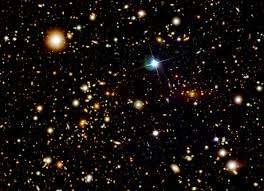
The current, observable universe has been determined to have a width of 156 billion light years, with an error of less than 1%, by the latest deep-space telescope WMAP. At first, it might seem impossible that scientists are so sure of this astronomical measurement, but this figure has been narrowed by years of research and determined by several paths of inquiry. Also, the size of the universe is intimately dependent on its shape, age, acceleration, and total mass, so we are very confident in this figure.
In 2003, the Wilkinson Microwave Anisotropy Probe sent back enough data for scientists to publish extremely dependable studies that established two previously unknown facts about the universe. They determined our universe is flat, which means standard Euclidean geometry is valid on the largest scale. This can be understood by saying a straight line more or less stays a straight line for as long as it extends. They also established that the universe is accelerating at an ever-increasing rate, which means that all mass is flying
away from each other at faster and faster speeds. The WMAP data measured the temperature, called the cosmic microwave background radiation, of our observable universe with an unprecedented accuracy, to within a 5% error. From these facts, we can deduce figures such as the radius of the universe.
Remember that the size of the universe is not a constant value, nor is it the size of an object as we traditionally understand it. The size of the universe is actually the size of space itself, and as space expands, so does the space between planets, stars, and galaxies. At the beginning of the universe, the Big Bang created space and time as we know them. From that moment, space has been expanding, so we find its size by measuring how far light could have traveled since the Big Bang, along with how much space itself stretched.
We can only possibly look or communicate up to the edge, or "horizon," of where light has traveled since the beginning of the universe. The size of the universe means the space in which we can interact with anything. We will never ever know what is "beyond" this boundary, because there is no way to know anything about it, so it's illogical to consider the realm "outside" of our universe, or to wonder what we are expanding "into."
An independent measure of the size of our universe can be given by studying the oldest stars. The oldest stars we have found are probably somewhere between 11 and 14 billion light years old. If we had stars older than the largest distance light could have traveled, then we'd know there was something wrong with our calculations; there would not be enough time for them to evolve. However, these values are consistent with everything else we know about theuniverse.
Dari http://www.wisegeek.com/how-big-is-the-universe.htm
1 comment:
Salam..
Subhanallah..
all created by Allah is so wonderful
and being meaningful to human
wallahuaklam.
Post a Comment